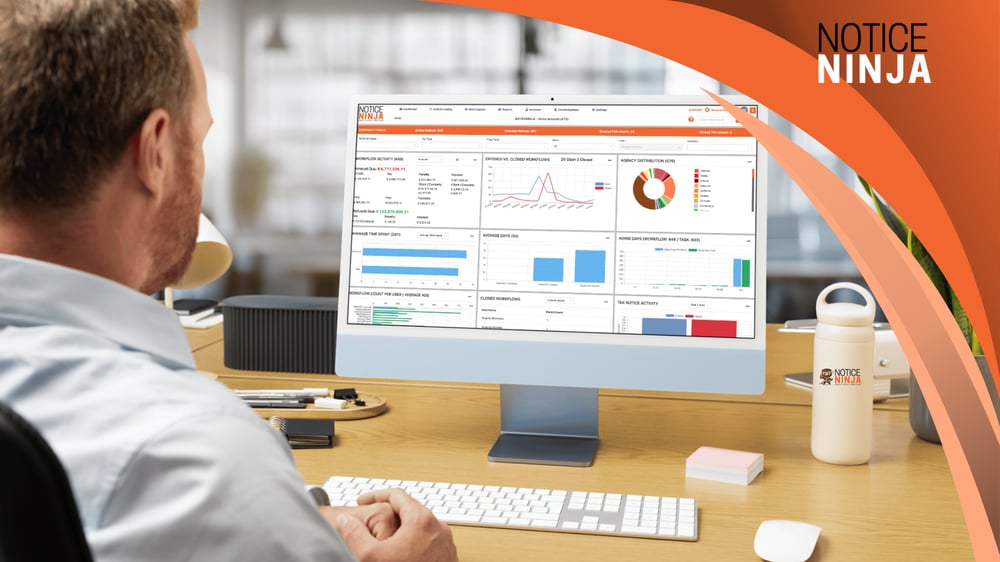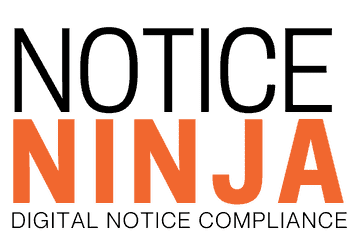Yes, NOTICENINJA is corporate tax notice compliance software that automates key workflows including notice assignments. The platform employs a rule-based system that can manage multiple level rules and ensure notices are directed to the appropriate stakeholder. As a result, you’ll never have to worry about notices being misdirected or slipping between the cracks.

Automating Corporate Tax Compliance Strengthens Controls and Reduces Risk

14 August
Simplifying Multi-Jurisdiction Compliance Through Automation
Automated compliance reporting is a technology-driven approach that transforms manual regulatory compliance processes into streamlined, efficient workflows using software solutions.
Corporate tax departments manage some of the most complex compliance requirements in any organization.
In addition to federal filings, teams must meet state, local, and sometimes industry-specific obligations. Operating across multiple jurisdictions means navigating different statutes, notice processes, and penalty structures.
The cost of late or inaccurate filings is significant. Penalties, increased audit risk, and reputational damage are real concerns. For public companies, weaknesses in compliance processes can also raise issues during internal control reviews under Sarbanes-Oxley (SOX).
Where Manual Tracking Creates Risk
Many corporate tax teams still rely on spreadsheets, shared drives, and email to manage deadlines and notices.
While familiar, these methods are prone to data entry errors, version control issues, and communication gaps between departments.
Manual tracking makes it difficult to maintain:
-
Jurisdiction-specific filing status across entities
-
Clear resolution timelines for notices
-
Effective escalation paths for exceptions
-
A complete audit trail for regulatory review
In a large corporate environment, these gaps increase compliance risk. They make it harder to enforce consistent processes and identify where controls are failing.
Automation as a Compliance Control
Automated compliance reporting replaces disconnected manual work with a structured, system-driven process.
By pulling data directly from source systems, automation validates information against jurisdictional rules and routes it through predefined workflows.
According to the Association of International Certified Professional Accountants (AICPA), technology adoption in compliance and accounting functions has become a critical factor in maintaining regulatory compliance while managing costs effectively.
This aligns with what corporate tax teams experience when automation becomes part of the compliance control framework. It reduces reliance on manual intervention while improving accuracy, timeliness, and transparency.
For corporate tax teams, this means:
-
Standardized workflows across all jurisdictions and entities
-
Centralized storage for notices, filings, and correspondence
-
Automatic assignment based on agency, account, or business unit criteria
-
A complete audit trail that meets evidentiary requirements for review
When implemented well, automation becomes part of the compliance control framework. It reduces reliance on manual intervention while improving accuracy, timeliness, and transparency.
Verified Impact in Corporate Environments
Aggregated client results confirm measurable improvements:
-
Average days-to-close reduced by 40–55 percent after implementation
-
Penalty exposure eliminated within the first reporting quarter for organizations with prior late payment assessments
-
Notice intake times reduced from five days to same-day entry, lowering the risk of missed deadlines
-
Greater visibility into jurisdictional trends, enabling targeted process changes and fewer recurring notices
These results are drawn from verified corporate tax use cases and anonymized to protect confidentiality.
Implementation Best Practices for Corporate Tax
When you have the right tool or software solution, this is what you will be able to do:
- Map Jurisdictional Obligations
Maintain an updated inventory of all filing requirements, deadlines, and exception thresholds
- Standardize Required Data Fields
Require fields like “Cause of Issue” and “Jurisdiction” for every notice to support analysis and reporting.
- Use AI and OCR for Data Validation
Optical Character Recognition captures data from notices, and AI matches it to source records for accuracy before workflow initiation.
- Apply Analytics for Control Monitoring
Track resolution times, notice volumes by jurisdiction, and overdue items to identify control gaps.
- Set Clear Escalation Rules
Automate alerts for high-risk items, such as notices approaching statutory deadlines or penalty triggers.T
Teams need to know how to use the system and understand why each step matters. When employees see the reasoning behind automated workflows, they become more comfortable adopting the technology and following the process as intended. This understanding makes onboarding smoother and encourages consistent usage across the team.
A Corporate Case in Point
A U.S.-based enterprise with tax operations spanning 15 states implemented automated reporting and routing to manage more than 800 notices annually.
In the first six months:
-
Entry-to-open time dropped from an average of five days to under 24 hours.
-
Overall resolution time decreased by 50%, with most notices closed in under 30 days unless inherently complex.
-
Management used cost center–level reporting to identify high-notice jurisdictions and address root causes, reducing incoming notice volume over the following year.
By consolidating processes and using the system’s dashboard analytics, the tax team shifted time from tracking deadlines to preparing strategic recommendations for leadership.
The Future Belongs to Automation (And AI)
In today’s regulatory environment, automation is no longer a convenience. It is an essential component of a strong compliance framework.
AI-powered workflows and OCR technology capture, read, and validate notice data automatically. Notices are scanned, parsed, and matched to existing records in real time. This accelerates intake and flags discrepancies early, ensuring complete and accurate reporting.
The benefits are clear: reduced penalty risk, stronger internal controls, and the ability to redirect skilled staff to strategic work.
Forward-looking corporate tax teams are using automation not only to meet compliance obligations but to transform compliance into a competitive advantage. By acting now, organizations position themselves to adapt quickly to evolving regulations without sacrificing accuracy or governance.
Next Step
If your corporate tax team is ready to move beyond manual tracking and disconnected workflows, start with a personalized compliance workflow audit. We will assess your current processes, identify automation opportunities, and outline the potential time and cost savings for your specific operation.
Download the Corporate Tax Buyer’s Guide or Request Your Workflow Audit.
RELATED POSTS
- A Guide to Resolving Corporate Tax Notices | Notice Ninja
- The Moment Tax Notice Compliance Becomes a Liability
- What to Know About Tax Operations | Notice Ninja Compliance Software
